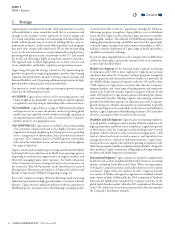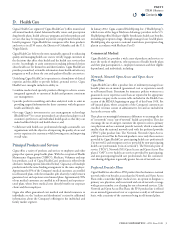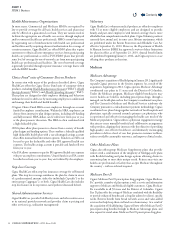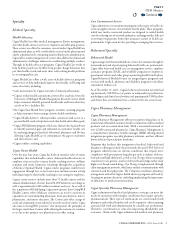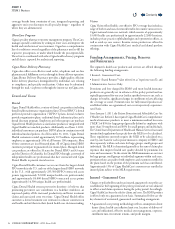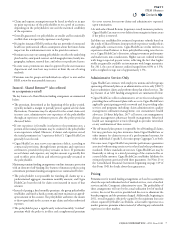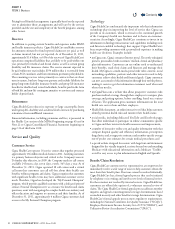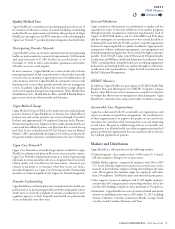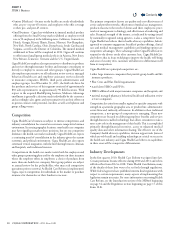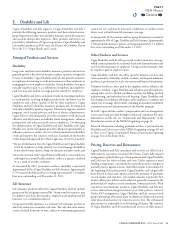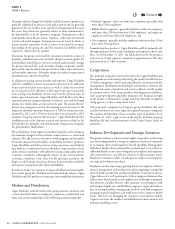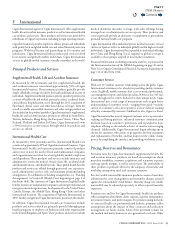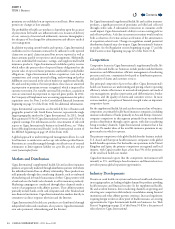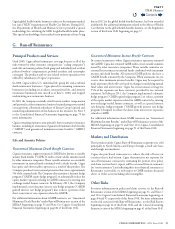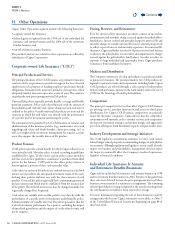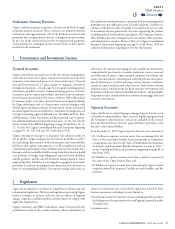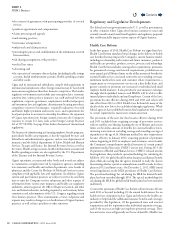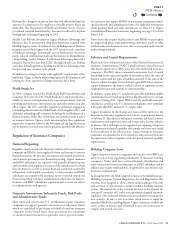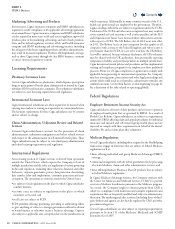Cigna 2011 Annual Report Download - page 32
Download and view the complete annual report
Please find page 32 of the 2011 Cigna annual report below. You can navigate through the pages in the report by either clicking on the pages listed below, or by using the keyword search tool below to find specific information within the annual report.
10 CIGNA CORPORATION2011 Form10K
PARTI
ITEM 1 Business
•Seniors (Medicare)- focuses on the health care needs of individuals
who are pre- or post-65 retirees and employers who oer coverage
to their pre- and post-65 retirees.
•
Small business- Cigna has withdrawn its insured medical product
oering from the Small Group market (dened as employers with
two to 50employees) in the following states: California, Connecticut,
Florida, Georgia, Hawaii, Illinois, Kansas, Missouri, New Hampshire,
New York, North Carolina, Ohio, Pennsylvania, South Carolina and
Virginia, as well as the District of Columbia. e insured medical
withdrawal in Texas will be completed in 2012. Cigna will continue
to oer insured small group medical policies in Arizona, New Jersey,
New Mexico, Tennessee, Vermont and the U.S. Virgin Islands.
Cigna HealthCare employs sales representatives to distribute its products
and services through insurance brokers and insurance consultants or
directly to employers, unions and other groups. Cigna HealthCare
also employs representatives to sell utilization review services, managed
behavioral health care and employee assistance services directly
to insurance companies, HMOs, third party administrators and
employer groups. As of December31,2011, the eld sales force for
the products and services of this segment consisted of approximately
830sales representatives in approximately 90eld locations. With
respect to the acquired HealthSpring business, Medicare Advantage
enrollment is generally a decision made individually by the customer,
and accordingly, sales agents and representatives focus their eorts on
in-person contacts with potential enrollees as well as telephonic and
group selling venues.
Competition
Cigna HealthCare’s business is subject to intense competition, and
industry consolidation has created an even more competitive business
environment. In certain geographic locations, some health care companies
may have signicant market share positions, but no one competitor
dominates the health care market nationally. Cigna HealthCare expects
a continuing trend of consolidation in the industry given the current
economic and political environment. Cigna HealthCare also expects
continued vertical integration, with the line blurring between clinicians
and hospitals, and traditional insurers.
Competition in the health care market exists both for employers and
other groups sponsoring plans and for the employees in those instances
where the employer oers its employees a choice of products from
more than one health care company. Most group policies are subject
to annual review by the policyholder, who may seek competitive
quotations prior to renewal. As Health Care Reform is implemented,
Cigna expects competition for individuals in the market to purchase
insurance for themselves or their families to increase.
e primary competitive factors are quality and cost-eectiveness of
service and provider networks; eectiveness of medical care management;
products that meet the needs of clients and their employees; price;
total cost management; technology; and eectiveness of marketing and
sales. Financial strength of the insurer, as indicated by ratings issued
by nationally recognized rating agencies, is also a competitive factor.
Cigna HealthCare believes that its health advocacy capabilities, holistic
approach to consumer engagement, breadth of product oerings, clinical
care and medical management capabilities and funding options are
competitive advantages. ese advantages allow Cigna HealthCare to
respond to the diverse needs of its customer base. Cigna HealthCare
also believes that its focus on helping to improve the health, well-being
and sense of security of its customers will allow it to dierentiate itself
from its competitors.
Cigna HealthCare’s principal competitors are:
•
other large insurance companies that provide group health and life
insurance products;
•Blue Cross and Blue Shield organizations;
•stand-alone HMOs and PPOs;
•
HMOs aliated with major insurance companies and hospitals; and
•
national managed pharmacy, behavioral health and utilization review
services companies.
Competition also arises from smaller regional or specialty companies with
strength in a particular geographic area or product line, administrative
service rms and, indirectly, self-insurers. In addition to these traditional
competitors, a new group of competitors is emerging. ese new
competitors are focused on delivering employee benets and services
through Internet-enabled technology that allows consumers to take a
more active role in the management of their health. is is accomplished
primarily through nancial incentives, access to enhanced medical
quality data and other information sharing. e eective use of the
Company’s health advocacy capabilities, decision support tools (some of
which are web-based) and enabling technology are critical to success in
the health care industry, and Cigna HealthCare believes its capabilities
in these areas will be competitive dierentiators.
Industry Developments
In the rst quarter 2010, Health Care Reform was signed into law.
Certain provisions became eective during 2010 and 2011 and others
will take eect from 2012 to 2018. Under Health Care Reform, many
of the details of these laws were to be set forth through regulations.
While federal agencies have published interim nal regulations with
respect to certain requirements, many aspects of implementing this
legislation remain uncertain. For more information concerning Health
Care Reform, see the Introduction section of the MD&A beginning
on page34 and the Regulation section beginning on page17 of this
Form10-K.
Contents
Q




